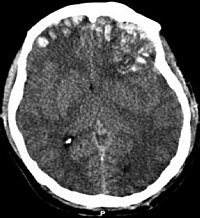
Photo from wikipedia
ABSTRACT Objective In the US, the prevalence of traumatic subdural hematoma (TSDH) continues to increase. Using a nationally representative sample of discharge records of patients with TSDH, the study objectives… Click to show full abstract
ABSTRACT Objective In the US, the prevalence of traumatic subdural hematoma (TSDH) continues to increase. Using a nationally representative sample of discharge records of patients with TSDH, the study objectives were to estimate trend in number of TSDH cases, surgical management, inpatient cost, length of stay (LOS), mortality rate, and complication rate; and to identify the association of sociodemographic, clinical and hospital characteristics with complications and mortality. Method We identified patients with a primary diagnosis of TSDH from the National Inpatient Sample (NIS) database from 2010 to 2017. Quarterly and monthly trends were estimated using interrupted time series design. Multivariate logistic regressions measured association between various factors and inpatient death and complications. Results Number of cases, mean LOS, rate of complication increased. Proportion of patients undergoing surgery, mean inpatient cost, inpatient mortality decreased. Mean inpatient cost was $23,182.40 and LOS was 6.41 days. Odds of inpatient death and complications increased with injury severity score and comorbid conditions requiring use of anticoagulants. Odds of inpatient death were highest among those ≥85 years old and in south and northeast region. Conclusion Given the increase in prevalence of TSDH in USA, additional resources should be allocated toward improving patient outcomes and lowering healthcare costs.
Journal Title: Brain Injury
Year Published: 2022
Link to full text (if available)
Share on Social Media: Sign Up to like & get
recommendations!